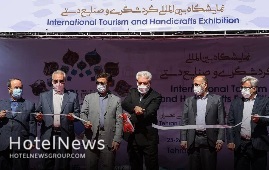
Tehran’s international tourism and handicrafts fair opened to the public on Tuesday in defiance of a government campaign to improve the hugely-battered travel sector in the face of the novel coronavirus. Cultural Heritage, Tourism, and Handicrafts Minister Ali-Asghar Mounesan and his deputies for tourism, and handicrafts were amongst attendees to the opening ceremony of the fair, which is underway at Tehran Permanent International Fairgrounds. Activists, including tour operators, hoteliers, transport businesses, and tour guides, are hopeful that such days would be numbered at the COVID-19 vaccine is getting more widespread. Since it first surfaced late in 2019, the pandemic has created a greater demand for experiences away from crowds, which is opposite to many traveling pillars. Experts say that such preference for solo travel would probably continue till a coronavirus vaccine is ever-present. “Safe and Responsible Travels” has been picked as the motto of the four-day event that according to organizers could help boost synergy among the two sectors as people have a chance to visit them maybe in a day-long visit! The event is being held according to health protocols announced by the National Headquarters for Coronavirus Control, and following the necessary coordination with the relevant agencies in this field, according to Vali Teymouri, the deputy minister for tourism. Travel agencies, airlines, sea or rail companies, entrepreneurs, startups, banks, insurance brokers, agents or hospitals in charge of health, medical tourism, sports clubs, pilgrimage & eco-tourism companies, representatives of hotels, guesthouses, touristic villages, and free zones are amongst exhibitors in the tourism sector. Furthermore, tens of booths and stands in various exhibition halls have been dedicated to craftspeople, artisans, live performers, and tribespeople who are coming together from every corner of the ancient land to promote skills inherited from generation to generation. Though its main goal of the sales exhibit is to make money and sails of the handicrafts, souvenirs, foodstuff, and various other regional products, it can be a venue for dialogue between exhibitors and visitors and even visiting officials, according to organizers. The fair showcase arrays of personal ornamentation, woodwork, illuminated manuscript, miniature, textile printing, enamel, leatherwork, handwoven textile, calligraphy, traditional musical instrument, metalwork, and marquetry among tens of others while nomadic culinary arts, live workshops, and performances that would gather own fans every corner. Iran expects to reap a bonanza from its numerous tourist spots such as bazaars, museums, mosques, bridges, bathhouses, madrasas, mausoleums, churches, towers, and mansions, of which 24 being inscribed on the UNESCO World Heritage list. Under the 2025 Tourism Vision Plan, it aims to increase the number of tourist arrivals from 4.8 million in 2014 to 20 million in 2025. So it will undeniably try its best to achieve a relatively ambitious goal but when that happens the travel industry is likely to look more altered.
Create: Feb 24, 2021 Edit: Feb 24, 2021 Regional News
Venezuelan Tourism and Foreign Trade Minister Felix Ramon Plasencia Gonzalez will visit Iran in the next few days to discuss tourism cooperation, Caracas’ Ambassador to Tehran Carlos Antonio Alcala Cordones has said. “Felix Plasencia is going to visit Iran next week to sign a Memorandum of Understanding on expansion of tourism cooperation with the Islamic Republic,” IRNA quoted the envoy as saying on Wednesday. The Venezuelan ambassador made the remarks on Wednesday night in a meeting with Iran’s Cultural Heritage, Tourism and Handicrafts Minister Ali-Asghar Mounesan, noting that Plasencia’s visit is aimed at paving the way for more collaboration in the tourism industry. The ambassador also noted that he has been in Iran for two years and it is obvious that a short visit by the Venezuelan minister will not give him enough time to get acquainted with the history and tourist attractions of the country, the report said. Cordones underlined that joint venture in the tourism industry will bolster ties between Iran and Venezuela and help the two countries’ economies. He further noted that Plasencia intends to offer a pavilion to Iran at the International Tourism Fair of Venezuela. For his part, Mounesan said that during a webinar with former Venezuelan tourism minister, both sides decided to expand tourism ties and hold an introductory tour. The Iranian minister added that the two countries are going to sign an MoU to expand cooperation in the tourism industry and that tourism practitioners from Venezuela and Iran will hold talks for future cooperation. The Ministry of Cultural Heritage, Tourism and Handicrafts has determined a five-day trip for the Venezuelan delegation, but it seems that they are going to stay less time in Iran, he noted. The relationship between Venezuela and Iran became more serious following an official visit by the then Venezuelan President Hugo Chavez to Tehran in 2001. Now, the two nations are determined to expand cooperation in tourism, the news agency explained. According to previous agreements, Venezuelan and Iranian nationals can have visa-free travels to each others' countries to stay for two weeks. The visit by the Venezuelan minister is expected to pave the ground for expansion of cooperation in cultural, economic, and political fields as well. Last November, Mounesan said that visa-free access and direct flights are the two important advantages for Iran and Venezuela to develop tourism cooperation. “We are ready to expand our relations with Venezuela in the arena of tourism by organizing familiarization tours in both countries with the participation of the private sector,” Mounesan said in a meeting with the Venezuelan ambassador. Back in October, Mounesan exchanged views with Plasencia, in a video conference to deepen tourism relations, especially through simplifying visa rules, launching fam tours, and setting up exhibits. They also agreed to sign a memorandum of understanding in a bid to broaden bilateral ties. Iran expects to reap a bonanza from its numerous tourist spots such as bazaars, museums, mosques, bridges, bathhouses, madrasas, mausoleums, churches, towers, and mansions, of which 24 being inscribed on the UNESCO World Heritage list. Under the 2025 Tourism Vision Plan, it aims to increase the number of tourist arrivals from 4.8 million in 2014 to 20 million in 2025. So it will undeniably try its best to achieve a relatively ambitious goal but when that happens the travel industry is likely to look more altered.
Create: Feb 20, 2021 Edit: Feb 20, 2021 Regional News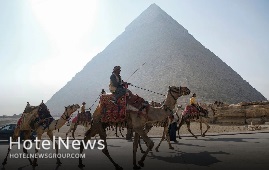
Egyptian tourism agencies are being forced to sell their assets in an attempt to stay afloat as a result of the drop in sales due to the global coronavirus pandemic, the head of the tourism and aviation division at the Alexandria Chamber of Commerce announced yesterday. Hossam El-Helou told local media that some of the companies had resorted to selling their assets at "any possible price as financial pressures increase." The country's tourism ministry recently said that it had allocated three billion Egyptian pounds ($192.1 million) in loans for business owners suffering from the implications of the pandemic, granting a "maximum of 30 million pounds [$1.9 million] to businessmen with one company", while lending "up to 40 million pounds [$2.56 million] for businessmen who own multiple firms." The ministry explained that the move had come due to the "continuation of the global crisis", noting that the loan was set at a five per cent interest "so business owners could retain their workers and pay their salaries." So far, a total of 174,426 people have contracted COVID-19 in Egypt, 10,050 of whom have died, and 135,349 others have recovered, according to Worldometer.
Create: Feb 17, 2021 Edit: Feb 17, 2021 International News
The highly anticipated Kimpton Sylvan Hotel in Atlanta is now officially open. Tucked away in the elegant neighborhood of Buckhead, The Sylvan Hotel is a 1950s-era adaptive reuse boutique hotel with a mid-century modern design scheme, complimented by a splash of understated sophistication and heartfelt Southern hospitality. The hotel includes 217 guest rooms, a vibrant living room lobby, a refreshing private pool, and over 4,000 square feet of meetings and events space. Aptly inspired by Atlanta’s nickname of “the city in a forest” and the arboreal abundance in the hotel’s own backyard, the name “Sylvan” is derived from the Latin term “silva,” meaning “forest.” Themes of trees, greenery, and nature resonate throughout the hotel, from the guest rooms to the lobby and beyond. FOOD & BEVERAGE:The crown jewels of The Sylvan are its three unique indoor and outdoor dining and drinking concepts: The Betty, Willow Bar, and St. Julep. The Betty features an elegant, old-Hollywood atmosphere and Continental cuisine from Executive Chef Brandon Chavannes. Seamlessly blending intimate sophistication and Southern hospitality, the menus nod to mid-century supper clubs, but with modern twists. The lavish restaurant features 175 seats throughout its interior dining room, bar, and a 1,100-square-foot outdoor patio – creating the perfect gathering place for Atlantans and visitors alike. Willow Bar, a dreamy, tucked away outdoor garden bar, and St Julep, a funky rooftop bar and restaurant with panoramic Buckhead views, will both open later this spring. THE DESIGN:Throughout the entire property – from the guest rooms to the restaurants and bars – one of the primary intentions of The Sylvan Hotel’s design team was to work with the inspiring bones of the mid-century building and create a series of intimate spaces visually connected to one another with a subtle shift of identity and vibe as you move through them. Each space connects to the property’s surrounding greenery and allows natural light to filter in and highlight a beautifully edited palette that’s bright and precisely executed with original furniture pieces. The focus of the lobby living room is an oversized, curved fireplace wall accented with glazed tile and stone, and afternoon light from the lobby-adjacent Willow Bar filters through a stained-glass wall composed of sweet, gentle pastels that add a spectacular glow to the living room’s clean palette. As they move through the space, guests will find that each of the restaurant and bar venues maintains its own personality: The Betty is dark and moody with a charming nostalgic nod; Willow Bar transports guests through meandering pathways to a delightful garden appointed with one-of-a-kind vintage pieces and a series of tucked-away spaces that can be made private or communal; and St. Julep showcases an unexpected combination of color and pattern that’s accentuated by a combination of funky furniture finds. The Sylvan also boasts a highly curated and eccentric art collection. Selected in conjunction with Soho Myriad Art Consulting, the hotel’s art display ranges from contemporary to vintage pieces featuring artists from Atlanta and beyond. Led by Matthew Goodrich of New York City’s award-winning design firm Goodrich and Kimpton’s Global SVP of Design, Ave Bradley, the property has been transformed into a mid-century dream as The Kimpton Sylvan Hotel welcomes guests into the glamorous world of days-gone-by. THE ROOMS:Featuring 217 spectacularly appointed spaces, the guestrooms at The Sylvan Hotel are incomparably en vogue, designed with simple lines, intriguing textures, and contemporary comforts like apothecary bath potions, Frette linens, cozy bathrobes, and skyline or garden views. And the hotel’s past life as a luxury community has laid the groundwork for an abundance of guest amenities, including: State-of-the-art fitness centerCruiser bikes for breezy ridesSpecial comforts for your petsHosted evening social hourMorning coffee + tea serviceIn-room yoga matsSame-day dry cleaning and laundryPremium Bluetooth speakersDaily newspapers delivered electronicallyFor guests interested in little extra space and flair, the Magnolia Hospitality Suite features unfettered access to the charms of privacy and poolside living. Guests may host gatherings of up to 50 friends amid a modern-meets-retro design, a living room of stylish furnishings and modern technology, and a dining table for ten. A spacious bathroom and queen-size Murphy bed round out the conveniences. For open-air festivities, guests may simply step out onto the adjoining poolside patio and enjoy the Georgia breeze. MEETINGS, WEDDINGS, AND EVENTS:The Sylvan Hotel has over 4,000 square feet of sophisticated meeting and event space – each aptly named for a tree or flower that can be found in Buckhead – built for guests who place a premium on personal service and boutique design. The beautiful 1,900-square-foot Camellia Ballroom – perfect for weddings and large events – accommodates groups of up to 225 reception-style or 125 banquet-style, while two smaller meeting rooms – the intimate Dogwood, with a capacity of 14 people, and the Gingko, which can hold 25-70 – are ideal for board meetings, private dinners or receptions, and small group off-sites. When it’s time for a team gathering — or simply a break from all-day meetings — the hotel has curated a number of local experiences to allow meeting groups to get a feel for the unique culture and flavors of Atlanta. KIMPTON’S APPROACH TO CLEAN:The Sylvan Hotel team is continuing to monitor developments and follow guidance provided by the Center for Disease Control and Prevention (CDC), Word Health Organization (WHO), and the State of Georgia. In addition to their rigorous standard housekeeping routines, frequency of cleanings has been increased and the team is performing enhanced disinfection protocols in the hotel and all restaurants. Please read more about the hotel’s safety protocols and Kimpton’s Approach to Clean here.
Create: Feb 13, 2021 Edit: Feb 13, 2021 International News
Wyndham Hotels & Resorts (NYSE: WH) today announced results for the three months and year ended December 31, 2020. Highlights include: Diluted loss per share for the quarter was $0.08 and adjusted diluted earnings per share was $0.07; diluted loss per share for the full-year was $1.42 and adjusted diluted earnings per share was $1.03. Net loss for the quarter was $7 million and adjusted net income was $7 million; net loss for the full-year was $132 million and adjusted net income was $96 million. Adjusted EBITDA was $56 million for the quarter and $327 million for the full-year. Global comparable RevPAR for the quarter declined 33% year-over-year; global comparable RevPAR for the year declined 35% year-over-year. System-wide rooms declined 4% year-over-year. Net cash provided by operating activities for the full-year was $67 million and free cash flow was $34 million. Paid quarterly cash dividend of $0.08 per share in fourth quarter, and Board of Directors recently authorized a 100% increase in the quarterly cash dividend to $0.16 per share beginning with the dividend expected to be declared in first quarter 2021. Repaid all remaining revolver credit facility borrowings. “We generated strong adjusted EBITDA and free cash flow in the worst year our industry has ever experienced. At the same time, we strengthened our portfolio with the completion of our strategic termination plan and drove sequential growth in hotel openings and our development pipeline,” said Geoffrey A. Ballotti, president and chief executive officer. “Our non-urban, drive-to economy and midscale hotels, combined with our ongoing investment in sales and marketing, captured rising pent-up leisure travel demand, which continued to produce sequential RevPAR improvements and domestic market share gains for our franchisees over the course of 2020.” Fourth Quarter 2020 Operating Results Revenues declined from $492 million in the fourth quarter of 2019 to $296 million in the fourth quarter of 2020. The decline includes lower pass-through cost-reimbursement revenues of $70 million, which have no impact on adjusted EBITDA, in the Company’s hotel management business. Excluding cost-reimbursement revenues, revenues declined $126 million primarily reflecting a 33% decline in comparable RevPAR and the impact from hotels temporarily closed due to COVID-19, as well as a $15 million decline in license and other fees also reflecting the impact of COVID-19 on travel demand globally. The Company generated a net loss of $7 million, or $0.08 per diluted share, compared to net income of $64 million, or $0.68 per diluted share, in the fourth quarter of 2019. The decrease of $71 million, or $0.76 per diluted share, was primarily due to the RevPAR and license fee declines, as well as excess marketing fund spend, which were partially offset by cost containment initiatives, lower volume-related expenses and the absence of transaction-related expenses. Full reconciliations of GAAP results to the Company’s non-GAAP adjusted measures for all reported periods appear in the tables to this press release. Full-Year 2020 Operating Results Revenues declined from $2,053 million in 2019 to $1,300 million in 2020. The decline includes lower pass-through cost-reimbursement revenues of $273 million, which have no impact on adjusted EBITDA, in the Company’s hotel management business. Excluding cost-reimbursement revenues, revenues declined $480 million primarily reflecting a 35% decline in comparable RevPAR and the impact from hotels temporarily closed due to COVID-19, as well as a $47 million decline in license and other fees also reflecting the impact of COVID-19 on travel demand globally. The Company generated a net loss of $132 million, or $1.42 per diluted share, in 2020 compared to net income of $157 million, or $1.62 per diluted share, in 2019. The decline of $289 million, or $3.04 per diluted share, was primarily due to the revenue decline, impact of the non-cash impairment charges and excess marketing fund spend, which were partially offset by cost containment initiatives, lower volume-related, separation-related and transaction-related expenses and the absence of contract termination expenses. Full reconciliations of GAAP results to the Company’s non-GAAP adjusted measures for all reported periods appear in the tables to this press release.
Create: Feb 13, 2021 Edit: Feb 13, 2021 International News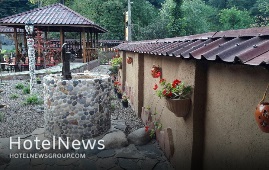
A total of 250 tourism-related projects worth 250 trillion rials ($5.9 billion at the official exchange rate of 42,000 rials per dollar) are being implemented across the northern Iranian province of Mazandaran. On Thursday, Seifollah Farzaneh, the provincial tourism chief, called on potential private investors to help fund the [unfinished] projects to have them implemented ahead of the schedule. “We expect all banks [and potential private investors] to come to the fore to help complete those projects, which are under construction and semi-finished.” This way a large number of native young people will be gaining employment opportunities when these projects are completed, the official said. Elsewhere in his remarks, the official pointed to several tourism projects recently inaugurated across the lush green province. Although the province’s tourism sector is struggling with different problems and issues due to the outbreak of the coronavirus, 23 tourism-related projects were inaugurated across the province on the occasion of Fajr celebrations (Jan. 31- Feb. 10, marking the victory anniversary of the Islamic Revolution), he said. Worth 3.2 trillion rials ($76 million), the recently-inaugurated projects included a 20-room hotel and 22 eco-lodge units, which are expected to create 129 job opportunities for the locals, he explained. Minister of Cultural Heritage, Tourism and Handicrafts Ali-Asghar Mounesan announced in August 2020 that Iran’s travel sector had suffered a loss of 12 trillion rials (some $2.85 billion) since the outbreak of the coronavirus pandemic, however, he mentioned that all the tourism businesses across the country would have the capacity to fully resume their activities both in domestic and foreign markets. “Many tourism projects have been completed, or are being implemented, showing that a very good capacity has been created in the field of tourism in the country and [this trend] should not be stopped,” the minister stated. Mounesan added 2,451 tourism-related projects worth 1,370 trillion rials (around $32 billion) are being implemented across the country that signals a prosperous future for Iran’s tourism sector. The tourism minister also said the coronavirus pandemic should not bring traveling to a complete standstill. “Corona is a fact, but can the virus stop tourism? Certainly not. For us, the coronavirus is a new experience in dealing with crises that teaches tourism experts around the world how to deal with such a disaster, and thankfully governments are turning this into an opportunity for better planning.” Iran expects to reap a bonanza from its numerous tourist spots such as bazaars, museums, mosques, bridges, bathhouses, madrasas, mausoleums, churches, towers, and mansions, of which 24 being inscribed on the UNESCO World Heritage list. Under the 2025 Tourism Vision Plan, it aims to increase the number of tourist arrivals from 4.8 million in 2014 to 20 million in 2025. The latest available data show eight million tourists visited the Islamic Republic during the first ten months of the past Iranian calendar year (started March 21, 2019).
Create: Feb 13, 2021 Edit: Feb 13, 2021 Regional News
The challenges the hospitality industry has faced in the wake of COVID-19 reminds us how critical the housekeeping department’s role is to a hotel’s overall success. The urgency to prevent the spread of COVID-19 has accelerated change in our industry, including the need for new hygiene and cleaning processes. Even before the virus, 78% of hotel guests believed cleanliness to be the most crucial factor affecting their choice of where to stay, with hotel cleaning protocols moving up to the #1 top-ranked category for travel with COVID-19. As guests expect the highest standards of sanitation to feel at ease in a hotel and once again return to travel, operators worldwide need to work with their housekeeping teams to better prepare for the impacts of these new realities. By using this time to further analyze housekeeping practices, hotel leaders have an opportunity to take advantage of advancing technologies to more accurately plan for operational shifts that, at the end of the day, influence bottom-line results. Here are a few ways hoteliers can prepare their housekeeping team for success in 2021. 1. Create a Structured Cleaning Program Using Industry Best PracticesTo earn guest confidence, hotels will have to demonstrate that they provide a clean and safe environment and are following specific disinfecting protocols. As part of this new dynamic, the ability to develop and implement proven strategies to meet these new cleanliness standards will be critical to staying ahead of the competition. This is a good opportunity to establish clear step-by-step standard operating procedures (SOPs) for the protocols needed to enhance cleaning regimens. Creating a distinct checklist for each area of the property, including the lobby, restrooms, common areas, fitness center, and guest rooms, will help to ensure nothing gets missed. Hotels can look to their brand or management company for guidance on a structured program, or they can leverage one from trusted industry organizations like the AHLA’s Safe Stay program or Amadeus’ disinfecting housekeeping checklist, endorsed by the International Executive Housekeeping Association (IEHA). 2. Alter Schedules for Guest Room Cleaning Based on NeedMany hotels are shifting away from daily cleaning with automatic opt-out cleaning programs, leading to, in some cases, dirtier rooms upon departure. At the same time, the enforcement of new hygiene protocols, including the expansion of high touchpoints and frequency of cleaning, can increase the amount of time needed to spend in a room. Updated practices on the use of disinfectants and surface dwell times can additionally alter the flow in which rooms are serviced. So, what does this mean for housekeeping and operational teams? The rise in guestroom cleaning times can make forecasting labor and servicing pop-up requests a more complex endeavor. Lack of planning for additional time can also cause strain on staff, while last minute modifications to departure room schedules can impact room readiness. By tracking and analyzing the labor and resources needed to execute the tasks these rooms now require, hotels can adjust to new cleaning schedules, while identifying valuable areas for improvement that will ultimately increase both staff and guest satisfaction. 3. Monitor How Many Hours Guest Rooms are VacantAs new guidance is issued for businesses to mitigate the risk of COVID-19, the procedures within hotels also need to adapt. For instance, the American Hotel & Lodging Association (AHLA) recommends rooms be left vacant for 24-72 hours prior to or after cleaning if possible, while China requires hotels that host international guests to change linens and clean guestrooms and bathrooms daily. Consumers are increasingly calculating risks associated with travel and want to have complete transparency when it comes to COVID-19-specific protocols before even booking a hotel room. The ability to promise, then track and report the number of hours a room is vacant is a must in today’s business environment. 4. Understand Which Rooms are Not Being Serviced and WhyStreamlining productivity may mean having to leave rooms not serviced for the day. Although a part of daily housekeeping, one of the biggest challenges is measuring why a room was not serviced, or “dropped”. Perhaps there is a need to alter opt-out programs. Perhaps there is a need for more staff. Having the ability to identify, record, and flag rooms with a special service status like “dropped rooms” allows teams to truly understand why rooms are not being serviced. This process allows housekeeping managers to schedule staff effectively, as well as audit and reconcile room counts at the end of each day to optimize operations. With today’s lack of time and budget, gaining important insights into dropped rooms is pivotal to every housekeeping team’s success. 5. Leverage Automation to Drive ProductivityAs we evaluate new ways to face the challenges ahead, hotel leaders must consider how innovation can play a critical role in closing the gaps between team capabilities and achieving business goals. The right hotel technology can be a powerful tool in the decision-making process by reaching across the hotel’s ecosystem to orchestrate proactive tasks such as automating room assignments, schedule turnovers, and reprioritizing work. Gaining valuable insights from automation dashboards and reporting tools can also enable better decision making in a world of unknowns. Whether it’s wiping down frequently used areas like elevator buttons, delivering guest requests like soap or chargers, or managing dropped or vacant rooms, modernizing processes with a housekeeping solution can help to maximize operational capabilities while ensuring the highest standards are met. During times of unpredictability, the ability to intelligently automate the prioritization, communication, and dispatching of the entire housekeeping operation is more valuable than ever. This way, limited time and budget is spent where it is needed most. Resetting for 2021 and BeyondMoving forward, there will be no greater focus from a guest’s perspective than a hotel’s commitment to its cleaning initiatives. Resetting for success in 2021 and beyond means understanding how technology can significantly enhance our capabilities as individuals and designing new business procedures that support it. Reflecting this dynamic presents an opportunity to lead the way in delivering the processes needed to support both housekeeping teams and guest confidence in this new era of hospitality.
Create: Feb 9, 2021 Edit: Feb 9, 2021 Housekeeping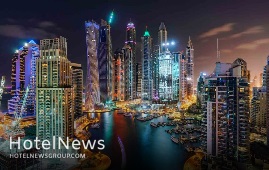
Millions of tourists are set to visit Dubai for the delayed Expo 2020, which is set to run from October 1 this year through to March 31 2022. The amusement and attractions industry has been buoyed by the promise of the resulting degree of "normal" business, promised by the director general of the emirate’s Department of Tourism and Commerce Marketing, Helal Al Marri. He asserted last week that the emirate is determined to go ahead with the celebration, despite the spike in infections that has occurred as a result of Dubai opening up to tourism just before Christmas. In fact, Al Marri blamed that spike on a small number of locals ignoring the regulations. “We are confident,” he said, “that we will be ready to make sure that the growth starts this summer, and by Expo in the fourth quarter, we look forward to welcoming the world.” The Expo is one of the world’s biggest organised events. If it goes ahead, it will generate billions in revenue for the government and the tourist industry in general. The infection rate in Dubai has risen four-fold over the Christmas and New Year period, but Al Marri was clear that the blame for this rested with the locals. He said: “We had a 98 per cent compliance and saw no increase in infections, but when that level of compliance dropped by a small margin, we saw the infection rate increase.” Since then, the UAE has been one of the world’s most efficient destinations in the roll-out of vaccinations, with around a third of the entire population inoculated by early February.
Create: Feb 8, 2021 Edit: Feb 8, 2021 International News
Japan's travel surplus in 2020 shrank to nearly one-fifth of the previous year, the first drop since the balance turned into the black in 2015, as international travel bans amid the coronavirus pandemic had a huge impact on the number of inbound visitors, government data showed Monday. The travel balance, which reflects the amount of money foreign visitors spend in Japan versus Japanese spending abroad, tumbled 79.2 percent to 562.1 billion yen ($5.3 billion) from a record 2.70 trillion yen in 2019 since annual comparable data became available in 1996, the Finance Ministry said in a preliminary report. Still, Japan's travel balance in 2020 logged black ink for the sixth straight year. In 2015, the balance saw its first black ink of 1.09 trillion yen since data compilation began in 1996, following a 44.4 billion yen deficit marked in 2014. Since 2011, when a massive earthquake, tsunami and the subsequent Fukushima nuclear crisis in northeastern Japan helped slightly widen a travel deficit to 1.30 trillion yen, the country's annual travel balance had continued to improve until 2019 with a steady increase in the number of foreign visitors. The reporting year's surplus in the current account, one of the widest gauges of international trade, fell 13.8 percent from 2019 to 17.70 trillion yen, its lowest level since 16.52 trillion yen recorded in 2015. It had increased 5.8 percent the previous year. In 2020, the goods trade balance saw a surplus for the fifth consecutive year, jumping almost eight-fold from the previous year to 3.05 trillion yen. The impact of a 15.0 percent decline in imports due to falls in prices of crude oil and other energy resources surpassed that of an 11.4 percent slip in exports amid sluggish demand for Japanese products such as cars and auto parts due to the pandemic. With the poor performance of the travel balance, services trade, which also includes cargo shipping, marked a 3.54 trillion yen deficit, following the first-ever surplus of 124.8 billion yen in 2019. It was the biggest red ink since the 3.81 trillion yen logged in 2012. The primary income balance, which reflects returns on overseas investments, showed a surplus of 20.72 trillion yen, the fourth largest since 1996, despite a 3.2 percent dip from a record 21.40 trillion yen in 2019, the first decline in four years. Many countries have imposed sweeping travel restrictions in response to the global spread of infections after the virus was first detected in China in late 2019. In 2020, 4.12 million foreigners visited Japan, which has promoted inbound tourism as a pillar of its growth strategy for revitalizing regional economies in recent years, plummeting a record 87.1 percent from 31.88 million in the previous year, according to the Japan Tourism Agency. Japan was originally scheduled to host the Tokyo Olympic and Paralympic Games last summer, but they were postponed for a year amid the pandemic. Largely consisting of tourists from China, South Korea and Taiwan, foreign visitors had kept expanding until 2019, when the figure hit a record high for the seventh year in a row. In December alone, Japan posted a current account surplus of 1.17 trillion yen, more than double the previous year's 544.9 billion yen to mark the 78th straight month of black ink. In the month, the country had a goods trade surplus of 965.1 billion yen and a services trade deficit of 343.5 billion yen. Primary income registered a surplus of 649.2 billion yen.
Create: Feb 8, 2021 Edit: Feb 8, 2021 International News
Iran’s southeastern Sistan-Baluchestan province has lost 1,440 billion rials ($34.2 million at the official exchange rate of 42,000 rials per dollar) in earnings from tourism as many potential visitors stay away due to the impact of the coronavirus, according to Alireza Jalalzaei, the provincial tourism chief. “Sistan-Baluchestan is a four-season travel destination and even though the province holds vast tourism capacities, it has taken some 1,440 billion rials hit from the coronavirus outbreak from mid-Esfand 1398 (early March 2020) to the end of the month Dey (January 19),” the official said on Wednesday. The official noted that Sistan-Baluchestan has set sights on [a significant] tourism development, and its travel infrastructure has been drastically extended over the past couple of years. “From the year 1396 (2017) onwards, the number of travel infrastructure in Sistan-Baluchestan has raised from 40 to 200 ones…. Nowadays tourism of this province has come to fame and distinction,” he explained. Elsewhere in his remarks, the official pointed to various tourism campaigns being launched over the past couple of years, adding the campaign ‘Let’s see Sistan, let’s hear Baluchestan’ has taken a noticeable impact on the tourism thrive of the province mainly by the means of on-line programs. “Despite all the bottlenecks, the province’s tourism has not been forced to shut….” “For instance, the occupancy rate of hotels in [the city of Chabahar] is [currently] more than 90 percent….. and currently, some 100 to 110 ecolodge unites are active across the province,” the official said. Last year, Cultural Heritage, Tourism, and Handicrafts Minister Ali-Asghar Mounesan said that the development of the travel industry across Sistan-Baluchestan province is among the top priorities for the ministry. “I am interested in Sistan-Baluchestan, and the development of this province is a priority for this ministry and the government,” the minister stated. “The majority of my travels during my tenure has been to Sistan-Baluchestan, which I consider it as a safe province with significant values in terms of culture, history, handicrafts, and tourism.” The collective province -- Sistan in the north and Baluchestan in the south -- accounts for one of the driest regions of Iran with a slight increase in rainfall from east to west, and an obvious rise in humidity in the coastal regions. In ancient times, the region was a crossword of the Indus Valley and the Babylonian civilizations. The province possesses special significance because of being located in a strategic and transit location, especially Chabahar which is the only ocean port in Iran and the best and easiest access route of the middle Asian countries to free waters. The vast province is home to several distinctive archaeological sites and natural attractions, including two UNESCO World Heritage sites, namely Shahr-e-Soukhteh (Burnt City) and Lut desert.
Create: Feb 6, 2021 Edit: Feb 6, 2021 Regional News
Red Sea Development Company, the developer of the mammoth tourism project on Saudi Arabia’s west coast, said it awarded contracts to complete structural work for a luxury hotel and villas. Saudi Arabian contractor Al Bawani will conduct civil and structural works across 40 hotel villas on the Southern Dunes site while Swiss timber specialist Blumer Lehmann will carry out planning, construction and fabrication works for a hotel on Ummahat Al Shaykh Island, the developer said in a statement on Wednesday. The company did not disclose the value of these contracts. The contract awards "signify the start of a new phase" for the mega tourism project as it advances into hotel development, John Pagano, chief executive of the Red Sea Development Company, said. “The Red Sea Development Company has made significant progress in terms of the design and construction of key infrastructure to enable the development of hotel assets,” he added. The project is a key tenet of Saudi Arabia's tourism strategy, which aims to increase the contribution of tourism to more than 10 per cent of the kingdom’s GDP by 2030, up from 3 per cent in 2020. The Red Sea Development Company’s masterplan covers a 28,000 square kilometre site containing 90 islands. Set to welcome its first visitors in 2022, the project is expected to be completed by 2030. It will house 50 hotels containing 8,000 rooms, a luxury marina, entertainment and leisure facilities. The company, which is owned by the kingdom’s Public Investment Fund, is developing 16 hotels with 3,000 rooms across five islands and two inland sites as part of the first phase that will be delivered by 2023. This phase will cost an estimated 28 billion Saudi riyals to 29bn riyals ($7.46bn-$7.73bn) to develop. Al Bawani's work will help the developer to link villas, restaurants and central buildings within its resort, the company said. Blumer Lehmann will design and manufacture all engineered timber material for a hotel, overwater and beach villas, spa and fitness building, restaurants and an arrival building. The company said last year it had awarded contracts worth 7.5bn riyals to date. Last month, the Red Sea Development Company chose Dublin-based DAA International to operate the project's international airport. It awarded the airport design contract to UK-based architecture firm Foster + Partners in October 2019. The project is being built under a “regenerative tourism” model, which aims not only to protect local habitats, but also create conditions for local environments to thrive. Only 22 of the site's 90 islands will be built on and visitor numbers to the area will be capped at one million a year.
Create: Feb 4, 2021 Edit: Feb 4, 2021 International News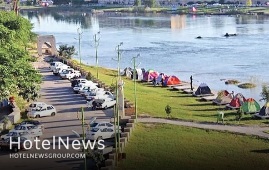
Well-planned travels during the Persian New Year (Noruz) holidays, which will start on March 20, would be possible in close coordination with the National Headquarters for Coronavirus Control, the deputy tourism minister said on Tuesday. In order to create social vitality during the holidays, the ministry has set some rules for possible Noruz trips to control and monitor them carefully, Vali Teymouri said. “The trips will be possible only within the framework of planned tours through licensed travel agencies and under the supervision of the tourism ministry.” For people, who travel individually and outside of the tours, a reservation for an authorized accommodation center will be necessary, the official added. He also emphasized that all travelers and tourists need to follow strict health protocols during their trips and stays. Last March, which is the most bustling and booming period for the tourism sector because it culminates in Noruz, all celebrations were canceled in all 31 provinces across the country, and all museums and historical sites, affiliated with the Ministry of Cultural Heritage, Tourism and Handicrafts went on a lockdown due to the coronavirus pandemic. Last year, before the Persian New year, the tourism minister Ali-Asghar Mounesan asked people to postpone or reschedule tours to help the tourism industry deal with the coronavirus outbreak. “My suggestion to my dear people is that they do not cancel their hotel reservations and domestic tours as far as possible to help the tourism industry and prevent it from bankruptcy by making their reservations in time after the virus is controlled.” Iranians made 74 million overnight stays in their domestic trips during the Noruz holidays two years ago (2019), which showed a 20 percent increase year on year. And some 132 million visits to tourist attractions were registered during the mentioned period, which showed a 34 percent growth year on year, according to data compiled by the Ministry of Cultural Heritage, Tourism and Handicrafts. The Islamic Republic was ranked the third fastest-growing tourism destination in the globe in 2019, with 27.9 percent growth year on year, according to the latest statistics released by the United Nations World Tourism Organization (UNWTO). However, the country expects to reap a bonanza from its numerous tourist spots. Under the 2025 Tourism Vision Plan, it aims to increase the number of tourist arrivals from 4.8 million in 2014 to 20 million in 2025.
Create: Feb 4, 2021 Edit: Feb 4, 2021 Regional News
